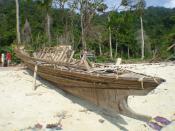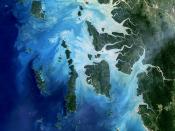For centuries the seminomadic Moken people have lived as hunter-gatherers, dwelling on boats or stilted dwellings along the coasts of Myanmar (Burma) and Thailand.
They harvest the sea's bounty by traditional methods. Without masks or scuba gear, they are able to gather tiny shellfish and other food on the ocean floor at depths as low as 75 feet (23 meters).
It's a difficult way to survive, but scientists have learned that these sea gypsies have an important edge. Studies of Moken children have shown them to have incredible underwater vision--twice as good as that of European children of the same age.
Anna Gislén, of Sweden's Lund University, did the study after hearing of the Moken's talents from a colleague.
"Another scientist, Erika Schagatay, was in the south of China working with sea nomads and their diving response," Gislén recalled. "She noticed that the children were picking out small brown clams from among brown stones.
To her, this was incomprehensible, as she could hardly see them with goggles, and the children used no such thing. It was not her area of science, so eventually it ended up on my desk."
Gislén ventured to Thailand's Surin islands where she conducted underwater tests on Moken children and compared their scores with those of European kids vacationing in the area. Her results were first published in the May 13, 2003 issue of Current Biology.
Gislén found no differences in the children's respective eye structures or in their vision on land. Underwater, however, it was a different story. The Moken children displayed underwater vision twice as sharp as their European counterparts.
Their secret lies in the way their eyes adapt to the underwater environment.
Underwater Adaptations
The refractive power of the eye's corneal surface, a key to clear vision, is greatly reduced underwater. The different...



Pasting quotes.
I don't think it's enough to just paste quotes and string them together as you have in this paper, you need to give thought as to why you put them there, what you're trying to get at, what your point is....it's not enough otherwise.
0 out of 1 people found this comment useful.